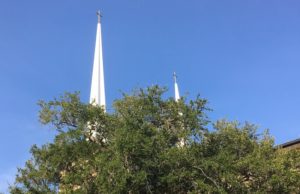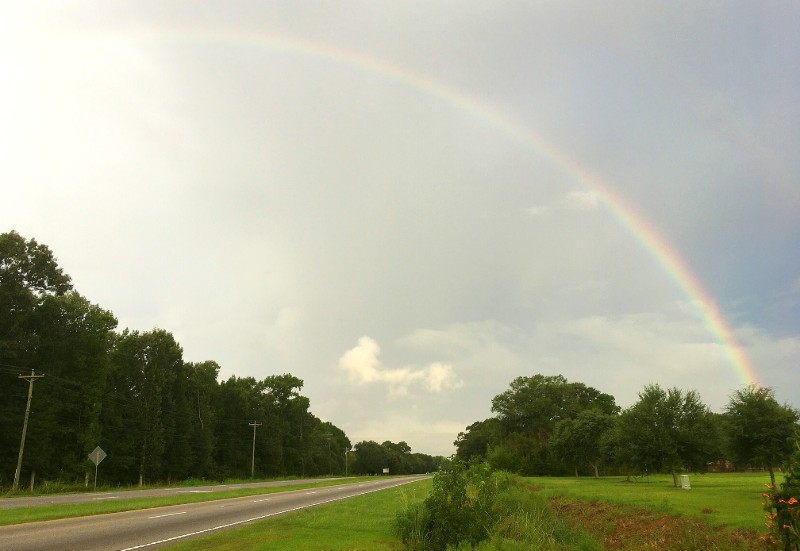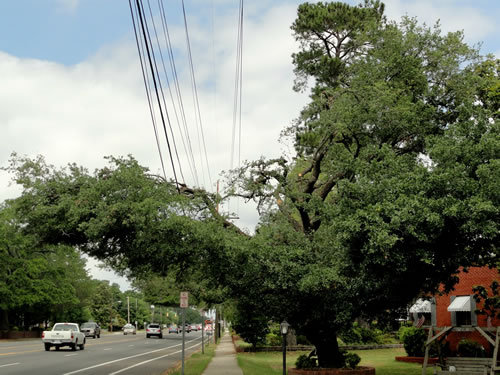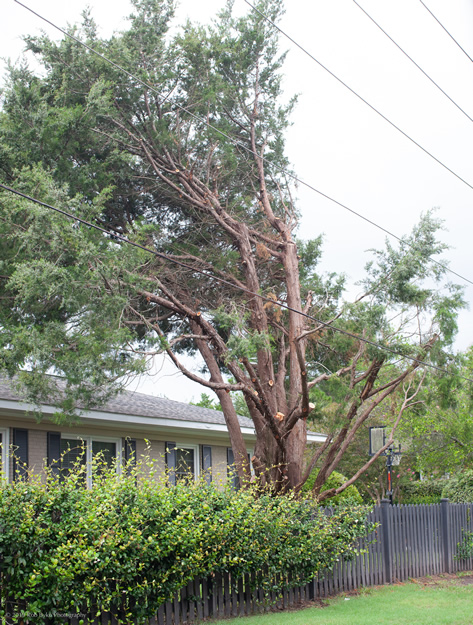Charleston Currents #11.39 | Aug. 19, 2019
SOMEWHERE OVER THE… The recent stormy weather brought a heartwarming sight just after dawn on Saturday — this end-to-end rainbow in West Ashley near the site of the federal vegetable laboratory. Great way to start a day.
 FOCUS, Morris: In challenging times, a diversified portfolio can be good news
FOCUS, Morris: In challenging times, a diversified portfolio can be good news
COMMENTARY, Brack: PSC needs to investigate Charleston-area tree butchery
IN THE SPOTLIGHT: Magnolia Plantation and Gardens
GOOD NEWS: Hootie hands help kids get ready for the return of school
FEEDBACK: Send us your letters
MYSTERY PHOTO: Peeking into where?
S.C. ENCYCLOPEDIA: Battle of Eutaw Springs
CALENDAR: Bird walk and free kayak trips Saturday
FOCUS: In challenging times, a diversified portfolio can be good news
By Kyra Morris, contributing editor | We can always focus on the problems. That is easy. But what if we change the focus to look for the opportunities or solutions? Then, perhaps, we’ll accomplish something worthwhile.
The markets and world events in today’s financial markets are creating a lot of uncertainties. The interest rate yield curve is inverted. Tariffs and their ultimate effect on our economy is unknown. The stock market is a roller coaster, to put it mildly. Uncertainties such as these stir up our fears, and this often leads to poor decisions. Our lives and investments are tied to the markets. What can we do to make sure that we do not fall into the trap of reacting emotionally from fear?
So we need to go back to the basics. Does the fluctuating stock market truly make a difference in your day-to-day life? If not, then let the markets do what they may, and see if you can invest as opportunities are created. If your daily life is affected, then it may be time to take a closer look at your total situation and revisit what is important. Are the concerning issues temporary? Then won’t they naturally work themselves out? Are your issues more prolonged and need more analysis? Again, begin with what is important and determine the solutions.
If there were a magic bullet for investment strategies, we’d all use it. There is not one. My firm adheres to strategies founded in academia based on creating a diversified portfolio of stocks that also has enough fixed income and reserves to allow you to feel some comfort riding through the ups and the downs of the markets. Markets will always go up and down, and business cycles will always occur.
Your investments should be based on your own goals and time frames. Do not try to outperform the markets. Sending a child to college in three years lends itself to a different model than retirement in 15 to 20 years. Your model(s) should relate directly to your plans and your goals – not what’s on the news tonight or what your neighbor’s goals are.
The U.S. market is in the midst of the longest recovery ever recorded, whereas foreign markets have lagged significantly. These differing markets do not follow each other, and there are times during which foreign markets significantly outperform our domestic market. A diversified portfolio should have foreign markets represented.
Tariffs are a troublesome question mark for investors. Tariffs do affect world trade and commerce. If we continue to use tariffs as a way to control world trade, this may create another reason to have foreign markets represented in your portfolio. Trading partners may arise outside of the U.S. These have strength within themselves. If you want to listen to an easy-to-understand podcast on tariffs that gives a history of their use and their effectiveness, go to “The Trouble With Tariffs” done by Charleston World Affairs Council member George Pope at this link. The fixed income, or bond, portion of your portfolio may be best used as a stabilizer. There is enough volatility in the stock market. When the stock market is going up, the fixed income piece lags, but when the stock market goes down, the fixed income piece is the better performer. An example: In December 2018 when the stock markets were down 7 percent, the bond markets were up 0.5 percent to 2 percent.
Diversification means not having the same type of investments, but different investments. You want investments that represent different parts of the markets and that do not move together simultaneously. Fixed income is not directly correlated with the stock market, and is a natural diversifier. It is diversification that creates less volatility in your portfolio over time.
If your lifestyle is not altered due to swings in the stock market or if your spending and cash management are under control and if your investments are set up based on your goals and strategies, relax and adjust your focus:
Reflect on the beauty and the goodness you have around you. Take a walk with a friend. Have a romantic candlelit dinner with your loved one(s). Play and laugh with your children, grandchildren or pets. Marvel at the creative ability of the artists in your community or the world-class chefs in your restaurants. Enjoy a beautiful sunrise or sunset.
Kyra H. Morris, a Certified Financial Planner, is CEO of Morris Financial Concepts, Inc., in Mount Pleasant. A national leader in the financial planning profession, she has been named several times by leading magazines as one of the country’s top financial planners.
- Have a comment? Send to: editor@charlestoncurrents.com
BRACK: PSC needs to investigate Charleston-area tree butchery
By Andy Brack, editor and publisher | The drama over the butchery of trees near power lines is too predictable. It’s time for something to change.
The narrative is, unfortunately, a four-part play:
 Act One: Contracted utility crews show up in a community and start pruning trees to keep limbs from being on top of power lines. If they don’t, they say, then the limbs will fall on lines in storms and interrupt power, which could take days to restore. It’s cheaper to remove the limbs.
Act One: Contracted utility crews show up in a community and start pruning trees to keep limbs from being on top of power lines. If they don’t, they say, then the limbs will fall on lines in storms and interrupt power, which could take days to restore. It’s cheaper to remove the limbs.
Act Two: Neighbors are aghast at how much the crews cut back their trees, sometimes “trimming” branches that are six- or eight-inches in diameter. Some trees are shadows of their former selves, either with big Vs missing from the middle of the tree or looking like they got a half of a Citadel haircut with nothing but nubs and fuzz on one side. Crews say nothing, despite folks who snap photos and try to get a word in edgewise.
Act Three: Neighbors call the media, which do stories about how communities are irked. The power company — it used to be SCE&G and now is Dominion Energy — makes soothing noises to placate neighbors, assuring neighbors that they’re cutting to industry standards (even though neighbors point to repeated examples of how crews went way over the line on many trees). Nevertheless, they mollify and soothe, seeming to speak from a script that tells them to listen, but do little more. (And the script always includes “public safety” because most people don’t want to challenge that concept.)
“We understand and respect the passion our customers have for the iconic beauty of trees across the Lowcountry, we work and live here, too,” Paul Fischer, public affairs specialist with Dominion Energy in North Charleston, told us Friday. “And while we appreciate all of the unique qualities that make each of our communities so special, public safety, as well as the safety of our crews in the field, remains our top priority.”
Act Four: The contracted crews soon are gone. Outraged neighbors seethe for awhile, but do little. Five years later when the crews return to prune again, the drama starts again. And crews generally cut more deeply, leaving worse scars on Charleston communities.
What’s ironic about this whole drama is that Dominion’s slogan is “Actions speak louder.”
Yes, they do. And despite all of the public relations rhetoric, these actions seem to show that contracted crews and the utility, by extension, are going to do what they want, regardless. They’ll soothe and placate, but they’ll keep butchering our neighborhoods.
When asked about a recent report by the city of Charleston that found Dominion’s contractors were not compliant in trimming nine out of 74 trees in West Ashley — what one activist calls a 12 percent failure rate that wouldn’t be acceptable in any business — here’s what Dominion’s Fischer said:
“As reported by other media outlets, the work reviewed by the city of Charleston was found to be overall compliant. According (to) the document released by the city, “some trees were determined to be non-compliant with the standards but were rendered so intentionally and with justifiable reasons.” Those reasons are defined in the report as “stub cuts” or “pruning to an adjacent limb” that will not become dominant. Both instances are designed to yield results that will “lead to a greening of the canopy” and ultimately enhance the aesthetics of the trees. After just a few months, many of the trees reviewed in this report have already begun to return to a more mature appearance.
“Tree trimming cannot be compared to manufacturing, as our work is not accomplished on an assembly line. Certified arborists and contractors in the field, working under a wide range of variables and dynamic conditions, recognize that each tree is different in structure, and our pruning practices take that into consideration. The trimming may or may not look exactly like the previous trim cycle depending on a number of factors including dead or diseased limbs and growth closer to primary wiring than in previous cycles. Consequently, the appearance may also vary from tree to tree once the work is complete. Our business model is comprised of delivering energy in a safe and reliable manner across a variety of environments. What remains constant is our commitment to safety and reliability.”
In the world of public relations, the longer the answer is, the more likely that someone has hit a nerve.
So what’s next? Do communities just repeat the narrative every five years or so?
We urge citizens, environmental stewards and neighborhood associations to contact the state Public Service Commission, which regulates utilities like Dominion, and demand an investigation into how the utility’s crews prune trees and manage the aftermath. Among the queries they can insist upon:
- How are utilities performing, compared to standards, in pruning trees? What percentage of trees are lost or mangled due to improper cuts? How does the cutting impact our communities?
- Are standards reasonable?
- How often do pruners exceed standards?
- What specific, written instructions does the utility give to contractors to deal with customers who don’t want trees cut?
- What specific, public relations strategies, tactics and documents does the utility have to manage inquiries about tree-pruning?
- What measures do pruners take before trees are cut to accommodate customers’ concerns about the severity of cuts? How often are trees cut without customer consideration?
- What do other states do to be more proactive in tree-cutting by utilities? Are there best practices not used in South Carolina, such as requiring a certified, independent arborist to accompany crews whenever cuts are made?
- What programs do states and local governments offer in other jurisdictions to mitigate the impact of cuts? For example, are there programs for governments and homeowners to share the expense of burying power lines, which would eliminate the need for pruning by utilities? (An internet search shows the cost of burying transmission lines can be 10 times to 14 times as expensive as overhead lines and can exceed $1 million per mile.)
We’re sure you can come up with more questions for PSC investigators. The point is if we don’t start doing something differently, nothing is going to change and the trees will continue to be butchered.
Why? Because “actions speak louder” than words.
Andy Brack’s new book, “We Can Do Better, South Carolina,” is now available for $14.99 in paperback via Amazon.
- Have a comment? Send to: editor@charlestoncurrents.com
SPOTLIGHT: Magnolia Plantation and Gardens
 The public spiritedness of our underwriters allows us to bring Charleston Currents to you at no cost. Today we shine our spotlight on Magnolia Plantation and Gardens, founded in 1676 by the Drayton family. It has survived the centuries and witnessed the history of our nation unfold before it from the American Revolution through the Civil War and beyond. It is the oldest public tourist site in the Lowcountry and the oldest public gardens in America, opening its doors to visitors in 1870. Open 365 days a year, Magnolia offers its visitors splendid tours of nature and history and the role African-Americans played in the development of its award-winning Romantic-style gardens.
The public spiritedness of our underwriters allows us to bring Charleston Currents to you at no cost. Today we shine our spotlight on Magnolia Plantation and Gardens, founded in 1676 by the Drayton family. It has survived the centuries and witnessed the history of our nation unfold before it from the American Revolution through the Civil War and beyond. It is the oldest public tourist site in the Lowcountry and the oldest public gardens in America, opening its doors to visitors in 1870. Open 365 days a year, Magnolia offers its visitors splendid tours of nature and history and the role African-Americans played in the development of its award-winning Romantic-style gardens.
- Visit www.magnoliaplantation.com to learn how you can experience a complete plantation experience.
- Click here to learn about events and what’s new.
- To meet all of our underwriters,click here.
Hootie hands help kids get ready for the return of school
Staff reports | Burke High School on Saturday hosted Charleston County School District’s 13th annual Hootie’s Homegrown Roundup.
The annual event provides K-12 school students with supplies and services donated by Hootie and the Blowfish, the Rotary Club of Charleston and local businesses striving to make an impact by giving kids a head start on the coming school year. Despite the threat of rain, the event was well-attended by hundreds of kids and their parents.
In other Good News:
![]() Welcome (back). Just as elementary and secondary school students are headed back to the classroom this week, so are students at various colleges. A big welcome to more than 3,000 freshmen at the College of Charleston, the Citadel, Charleston Southern University and the Charleston School of Law. Trident Technical College is expected to have a similar number of first-year students at its campuses. All totaled, more than 25,000 college students call the Charleston area their home for higher education.
Welcome (back). Just as elementary and secondary school students are headed back to the classroom this week, so are students at various colleges. A big welcome to more than 3,000 freshmen at the College of Charleston, the Citadel, Charleston Southern University and the Charleston School of Law. Trident Technical College is expected to have a similar number of first-year students at its campuses. All totaled, more than 25,000 college students call the Charleston area their home for higher education.
National Thrift Shop Day. Palmetto Goodwill celebrated this special day Saturday with a reminder to patrons and donors that more than 90 cents of every dollar spent locally goes back into local services that provide job placement and training programs. “Goodwill programs help people find jobs and advance their career, and serves anyone facing challenges to finding employment, including people with disabilities, older workers and youth, veterans and military families and people reentering the workforce after incarceration,” Palmetto Goodwill President and CEO Robert Smith said. “Palmetto Goodwill annually provides such services to over 15,000 people throughout our territory. In fact, last year alone we helped place 3,094 people into new jobs.
Good. The city of Charleston joined several other jurisdictions on April 15 filed in a state lawsuit against manufacturers and distributors of opioids, seeking to end the destructive effects of the narcotic pain pills and recoup tax dollars spent to fight the abuse epidemic. “Enough is enough,” Mayor John Tecklenburg said in a statement. “By bringing action against those who have contributed to this problem, we hope not just to recover the costs of our ongoing response to this crisis, but to help our citizens whose lives have been damaged by opioid use and to prevent this epidemic from wreaking further havoc on our community.”
Poet to be keynote. Nikki Giovanni, a world-renowned poet and educator, will be the featured keynote speaker 2 p.m. Oct. 2 at Black Ink, Charleston’s African-American book festival. It is a program of Charleston Friends of the LIbrary and a part of the MOJA Arts Festival. “She’s one of the most noted poets in America today and an inspiration for many,” said Friends Director Jeanell Marvin. “Whether she’s reading her own works or talking about contemporary issues, Nikki Giovanni has something to say that we all should pay attention to.” Cost: Free. Location: Memminger Auditorium, 56 Beaufain St., Charleston.
Send us your thoughts
We’d love to get your impact in one or more ways:
Send us a letter: We love hearing from readers. Comments are limited to 250 words or less. Please include your name and contact information. Send your letters to: editor@charlestoncurrents.com. | Read our feedback policy.
Tell us what you love about the Lowcountry. Send a short comment – 100 words to 150 words – that describes something you really enjoy about the Lowcountry. It can be big or small. It can be a place, a thing or something you see. It might the bakery where you get a morning croissant or a business or government entity doing a good job. We’ll highlight your entry in a coming issue of Charleston Currents. We look forward to hearing from you.
Peeking into where?
Dedicated James Island reader Archie Burkel, a.k.a. The Hat Lady, submitted this as a Mystery Photo and, boy, is it ever clever. Hint: It was taken in Charleston County. But what is the viewer looking at and where is it? Send your guess to editor@charlestoncurrents.com. And don’t forget to include your name and the town in which you live.
Our previous Mystery Photo
 Our Aug. 12 mystery, “Pair of crosses,” showed the new steeples at Blessed Sacrament Catholic Church on Savannah Highway in Charleston. Thirty years ago next month, Hurricane Hugo blew down the church’s original steeples.
Our Aug. 12 mystery, “Pair of crosses,” showed the new steeples at Blessed Sacrament Catholic Church on Savannah Highway in Charleston. Thirty years ago next month, Hurricane Hugo blew down the church’s original steeples.
Hats off to this week’s successful sleuths: Chris Brooks of Mount Pleasant; David Deen, Irene Smith, Rebecca Davis and Kristina Wheeler of West Ashley; George Graf of Palmyra, Va.; Stephen Yetman and Mia Maness of Charleston; and Jay Altman of Columbia.
Davis recalls the original steeples being installed when she attended Blessed Sacrament’s school.
Graf provided more context according to The Catholic Miscellany web site: “When Hurricane Hugo raked a path of destruction through Charleston on Sept. 22, 1989, among the storm’s most visible casualties were the twin steeples of Blessed Sacrament Church. The wind toppled the spires into the middle of Savannah Highway in front of the church.
“Father Romanoski said, ‘Many of the founding and longtime members have dreamed of replacing them, and this one family took it upon themselves to save for that occasion.’ In 2017, family members told him they had more than $160,000 to donate to the parish, with the stipulation that it be used only for new steeples. The new steeples were designed by Gary Boehm of Glick Boehm Architecture of Charleston, which has done several projects around the diocese.’
- Send us a mystery: If you have a photo that you believe will stump readers, send it along (but make sure to tell us what it is because it may stump us too!) Send it along to editor@charlestoncurrents.com.
HISTORY: Battle of Eutaw Springs

Image by Alonzo Chappel (1828-1887) via New York Public Library digital collections.
S.C. Encyclopedia | The Battle of Eutaw Springs was the last major engagement in South Carolina between American and British forces during the Revolutionary War. In the bloody encounter, some two thousand Continental and militia soldiers commanded by General Nathanael Greene clashed with 2,300 British regulars and Loyalists under Lieutenant Colonel Alexander Stewart. Although Greene was forced to leave the field, the British were equally mauled and retreated to Charleston, abandoning the South Carolina upcountry. The battle site is located in Orangeburg County near Eutawville, and a portion of the battlefield is a state historic site.
British forces were at Eutaw Springs on September 7, encamped near a sturdy two-story brick home with palisaded garden, when Greene completed the consolidation of his forces at Burdell’s plantation about seven miles away. Early the following morning, Greene put his army on the march. Stewart was not aware that the Americans were so close, and he had that morning sent out foragers to collect sweet potatoes. Four miles from Eutaw Springs, the vanguard of the American army ran into the British escort protecting the rooting party. Many of the unarmed foragers were captured. Reacting quickly, Stewart sent forward additional troops to delay the Americans and formed his main army in a single line about two hundred yards west of his Eutaw Springs campgrounds. He anchored his right flank on Eutaw Creek with the brick house, occupied by a covering force, behind the line.
Greene used a formation that had seen success at the Battle of Cowpens. The militiamen were placed in the front line, with the battle-hardened Continentals behind them in the second line. Advancing, the Americans pushed back the British skirmishers until they met the main body, at which point there began a bloody back-and-forth duel. Eventually the center of the American line began to buckle under the intense action, and Stewart directed an advance. But his forces became disorderly and Greene saw his opportunity. He ordered the Continentals forward in a bayonet attack that forced the British left flank to fall back and retreat through their campsite. On the verge of a major victory, many of the American troops thought the battle won and left the fighting to loot the British camp.
This action cost Greene his victory, for the British right flank had not retreated and those secure in the house began a heavy fire, which threw the Americans into confusion and allowed Stewart to rally his troops for a counterattack. Greene got control of his troops before disaster struck, and behind a covering force they retreated back to Burdell’s, leaving the field and two artillery pieces to the British. Losses on both sides were high: the British admitted to 683 killed, wounded, and missing; and the Americans reported 517. Among the American unit commanders were many notable patriots, including Francis Marion; Otho Williams; William Washington, who was captured; Henry Lee; Andrew Pickens, who was wounded; and Wade Hampton.
— Excerpted from an entry by Stephen D. Smith. This entry may not have been updated since 2006. To read more about this or 2,000 other entries about South Carolina, check out The South Carolina Encyclopedia, published in 2006 by USC Press. (Information used by permission.)
CALENDAR: Bird walk and free kayak trips Saturday
Staff reports | The National Park Service on Saturday will offer a bird walk and two free kayak trips from Fort Moultrie.
The two-hour bird walk will leave at 8 a.m. from the Fort Moultrie Visitor Center and will be led by local avian expert Sarah Diaz. The area of exploration will concentrate on the maritime forest and beach around Fort Moultrie. Participants should bring water, sunscreen, insect repellent and binoculars.
The beginner-level kayak trips require a reservation as space is very limited. Participants need to be able to paddle two-and-a-half miles in mildly windy conditions; be at least 18 years old; wear appropriate footwear; and, with gear, weighing 220 pounds or less. Sit-on-top kayaks, paddles, and life vests will be provided. Those with reservations will meet at the Fort Moultrie dock at 12:30 p.m. or 3:30 p.m. Spots will be filled on a first-come, first-served basis. Only email inquiries will be accepted until 5 p.m. Aug. 22. Send to: Paula_Ogden-Muse@nps.gov and responses about availability will be sent.
There is no charge for participation in either program, however, those wishing to explore the fort and use park facilities will need to pay the park entrance fee. Fort Moultrie is located at 1214 Middle Street, Sullivan’s Island, South Carolina. Fort Moultrie r is open daily from 9 a.m. to 5 p.m. and includes a visitor center with museum exhibits and an orientation film. More: www.nps.gov/fosu
Meeting on flooding: 6:30 p.m., Aug. 19, Wesley United Methodist Church, 2718 River Road, Johns Island. The Concerned Citizens of Johns Island and the Progressive Club of Johns Island will meet in coordination with the United Flooded States of America to discuss impacts on flooding in the Lowcountry. Food and refreshments will be provided.
Starlight Cinema: 8:30 p.m., Wednesdays, Freshfields Village, 149 Village Green Lane, Kiawah Island. Last movie of the season: Aug. 21: Lego Movie 2: The Second Part.
Spring Street Stroll: 4 p.m. to 9 p.m., Aug. 22, Spring Street. Charleston. You can share wine and canapes with several businesses that are co-hosting an evening stroll to showcase what they do. Co-hosts include Josephine Wine Bar, Taxidermy, Artisan Tees, Continuum Skate Shop, Dalilas, Warehouse, Tiger Lily, and Dishtination Guides. More on Facebook.
Events at the Gaillard. Check out these awesome coming events at the Charleston Gaillard Center, 95 Calhoun St., Charleston:
Homeless to Hope Fund Benefit: 6:30 p.m., Aug. 25. Join Charleston Mayor John Tecklenburg and Mount Pleasant Mayor Will Haynie for an uplifting musical celebration in support of the Homeless to Hope Fund. Entertainment line-up includes the Blue Dogs, soulful vocalist Zandrina Dunning and BlackNoyze Band, percussive Americana Rock band Rene Russell and the Bottom End and singers from the College of Charleston Choir, Charleston Symphony Chorus and Taylor Festival Choir under the direction of Dr. Rob Taylor. Tickets are $33 to $253.
Lowcountry Jazz Fest: Aug. 30 to Sept. 1, The All White Party Affair, set for Aug. 30 from 7:30 p.m. to 11 p.m.,will feature Grammy-nominated soul slinger Anthony David. Tickets are $85. The next evening at 7:30 p.m. is Day One of the festival, which will include several artists: The Sax Pack. Richard Elliott, Peter White, Keiko Matsui, DW3 and the West Coast Jam Horns. Tickets are $68 to $153. At 7:30 p.m. Sept. 1, DAy Two starts including Dave Koz and Friends Summer Horns with Gerald Albright, Rick Braun, Kenny Lattimore and Aubrey Logan; Marion Meadows; Kirk Whalum; and Jonathan Butler. Tickets are $68 to $153.
Footloose, the musical: Aug. 28 to Sept. 28, Dock Street Theatre, Charleston. Charleston Stage will present the 1980s movie-turned-rock-and-roll musical for the first time in a month of performances sponsored by the Henry and Sylvia Yaschik Foundation. Tickets are $29 to $71 for any of the 16 performances of the show. Buy tickets.
Wine Down Wednesday: 5 p.m. to 7 p.m. Sept. 11, Old Towne Creek County Park, Old Towne Road, West Ashley. Charleston County Parks will kick off this fall series of four events to allow you to enjoy wine, food and live music in a new park. Admission is $15 in advance of $20 at the gate. Other dates are Sept. 25, Oct. 9 and Oct. 23. More info.
The Reckoning: 1 p.m. to 5 p.m., Sept. 15, James Island County Park, James Island. The popular Grateful Dead tribute band returns to the county park in its off-leash dog park area. Beer and non-alcoholic drinks will be available for purchase, but no food is allowed into the dog park. Free with park admission of $2 per person. Dogs welcome, too!
Galivants Ferry Stump: 5 p.m., Sept. 16, Pee Dee Farms General Store, 125 West Highway 501, Galivants Ferry, S.C. Democratic presidential candidates will be vying for attention in a special edition of the nation’s oldest stump meeting in Horry County. Learn more here.
Early morning bird walks at Caw Caw: 8:30 a.m. every Wednesday and Saturday, Caw Caw Interpretive Center, Ravenel. You can learn about habitats and birds, butterflies and other organisms in this two-hour session. Registration is not required, but participants are to be 15 and up. $10 per person or free to Gold Pass holders. More: http://www.CharlestonCountyParks.com.
AREA MARKETS
TUESDAYS. The Mount Pleasant Farmers Market is every Tuesday from 3:30 p.m. to 7 p.m. at the market pavillion at Moultrie Middle School, 645 Coleman Blvd., Mount Pleasant. Free parking. Lots of activities. More info.
WEDNESDAYS. The West Ashley Farmers Market is every Wednesday from 3 p.m. to 7 p.m. in Ackerman Park off Sycamore Avenue in West Ashley. The last week of the market will be the first week of October. More.
FRIDAYS/SATURDAYS: Night Market. Every Friday and Saturday from 6:30 p.m. to 10:30 p.m. for the rest of the year, you can shop with 108 vendors, including artists and craftsmen, at the night market on Market Street between East Bay and Church streets. It’s more than four blocks of local shopping and fun. Free.
SATURDAYS: Johns Island Farmers Market operates each Saturday from 9:30 a.m. to 1:30 p.m. year-round with more than 50 local farmers and vendors, food trucks, music and more. The market is located on the campus of Charleston Collegiate School, 2024 Academy Road, Johns Island
SATURDAYS: The Charleston Farmers Market is open 8 a.m. to 2 p.m. in Marion Square each Saturday through Nov. 30. More info.
- If you have an event to list on our calendar, please send it to feedback@charlestoncurrents.com for consideration. The calendar is updated weekly on Mondays.
 If you like what you’ve been reading, how about considering a contribution so that we can continue to provide you with good news about Charleston and the Lowcountry. Interested? Just click the image below.
If you like what you’ve been reading, how about considering a contribution so that we can continue to provide you with good news about Charleston and the Lowcountry. Interested? Just click the image below.
OUR UNDERWRITERS
Charleston Currents is an underwriter-supported weekly online journal of good news about the Charleston area and Lowcountry of South Carolina.
- Meet our underwriters
- To learn more about how your organization or business can benefit, click here to contact us. Or give us a holler on the phone at: 843.670.3996.
OUR TEAM
Charleston Currents offers insightful community comment and good news on events each week. It cuts through the information clutter to offer the best of what’s happening locally.
- Mailing address: P.O. Box. 22261 | Charleston, SC 29413
- Phone: 843.670.3996
Charleston Currents is provided to you weekly by:
- Editor and publisher: Andy Brack, 843.670.3996
- Contributing editor, common good, Fred Palm
- Contributing editor, money: Kyra Morris
- Contributing editor, Palmetto Poem: Marjory Wentworth
- Contributing editor, real estate: Digit Matheny
- Contributing editor, AT: Jerry Adams
- Contributing photographer: Rob Byko
SUBSCRIBE FOR FREE
Subscriptions to Charleston Currents are free.
- Click here to subscribe.
- Unsubscribe. We don’t want to lose you as a reader of Charleston Currents, but if you must unsubscribe, you will have to do it through the email edition you receive. Just go to the bottom of any of your weekly newsletters and click the “unsubscribe” function. If that doesn’t work, please send us an email with the word “unsubscribe” in the subject line.
- © 2008-2019, Statehouse Report, LLC. All rights reserved. Charleston Currents is published every Monday by Statehouse Report LLC, PO Box 22261, Charleston, SC 29413.












 We Can Do Better, South Carolina!
We Can Do Better, South Carolina!























